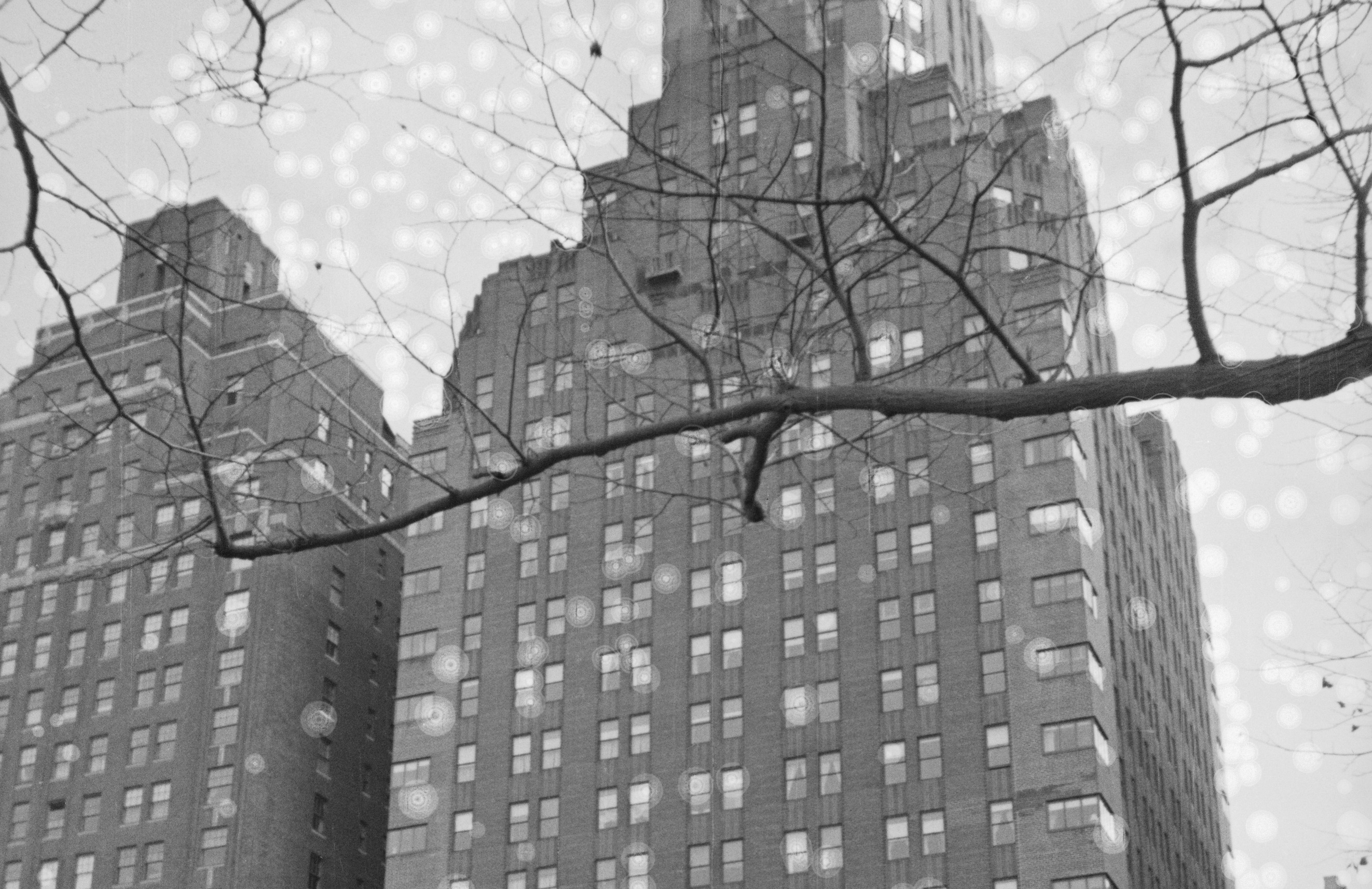
310 Riverside Drive
by Tom Miller
In 1920 Nicholas Roerich and his wife, Helena, arrived in New York City. The Russian-born mystic and artist promoted himself as a master in the theosophist belief in ancients who could transmit messages and knowledge to believers. He mesmerized wealthy Americans who formed a near-cult. (Reportedly, the spiritualist urged follower Henry Wallace, Secretary of Agriculture under Franklin Roosevelt, to persuade the Treasury Department to add the mystic pyramid of the Great Seal to the dollar bill—a changed that was enacted in 1935.)
Among his ardent followers were Louis L. Horch, a specialist in international finance, and his wife, Nettie. The couple were major financial backers of Roerich’s Master Institute of United Arts and the Roerich Museum, founded in 1923. Louis Horch was president of the museum and the couple owned hundreds of the artist’s paintings.
The Horches had established the museum in an apartment building they owned at No. 310 Riverside Drive. They took their dedication a step further in 1928 by purchasing the abutting properties at Nos. 311 and 312 and securing a bond to fund construction of a skyscraper on the site.
On August 2, 1928, the Ballston Spa Daily Journal announced, “A 24-story ‘skyscraper museum’ to cost in excess of $2, ooo, ooo is to be erected in Riverside Drive to house the Roerich Museum and two other art organizations. It will supplant the residential building at 310 Riverside Drive, at present occupied by the Roerich Museum, which is devoted to 750 paintings by Nicholas Roerich.” The article explained that the along with space for other organizations to be housed in the lower floors, a “number of small apartments, an auditorium, conference rooms and lecture halls, are embraced in the plans to be drawn by Helmle, Corbett & Harrison, and Sugarman and Berger.”
Harvey Wiley Corbett, a specialist in skyscraper design, took the reins in designing what would be called the Master Building–named after Roerich’s “Invisible Teacher, Master Morya.” His Art Deco design recalled his One Fifth Avenue, completed a year earlier, in its overall massing and series of setbacks. He used color to emphasize the verticality of the structure–the brick morphing from dark purple at the base to light gray at the top. He told a reporter from The New York Times his purpose in doing so was “to create the effect of a growing thing.” The wrap-around corner windows were the first in New York.
They took their dedication a step further in 1928 by purchasing the abutting properties at Nos. 311 and 312 and securing a bond to fund construction of a skyscraper on the site.
Completed in 1929, the Master Building described by The New York Times as “A formidable venture in combining living space and culture.” The lower three floors held the Roerich Museum, the Master Institute of United Arts, Corona Mundi Art Center, Urusvati Institute and other related institutions. The upper floors held 344 apartments–from one to three rooms in size–for artists. Because it was an apartment hotel, tenants had minimal kitchen facilities (called pantries), and ate for the most part in a large common restaurant.
On May 10, 1929, The Highland Democrat reported that the Master Institute of United Arts was “soon to move into new quarters in its twenty-four story Master Building.” The article explained that the institute “is organized in harmony with the teachings of its founder, Nicholas Roerich, the internationally renowned artist and philosopher, who believes that art in all its branches should be made easily accessible to all people. In accordance with this believe the Master Institute unites under one roof classes in music, painting, sculpture, architecture, opera, ballet and drama.”
The Roerich Museum opened five months later, on October 17, with Nicholas Roerich as guest of honor. The exhibition consisted of about 1,000 of Roerich’s paintings. The Horschs continued to be deeply involved. Nellie later told a reporter “We worked hard, day and night, but that was no sacrifice, it was our pleasure. We had no self-interest–we simply wanted to help artists and derived great satisfaction from their creative endeavors.”
The Depression years caused financial problems; but it was private tension between Roerich and Horsch (The New York Times described the problem saying, “The two men had a falling out”). Court battles ensued over who had control of the building. Louis Horsch awarded control by the courts in 1932, and the Roerich Museum was evicted in 1938.
On June 4 that year, The New York Sun reported on the opening of the “recently organized Riverside Museum.” The article said “The Roerich paintings which once clogged the walls, have been taken down and store elsewhere in the building, leaving seven spacious galleries on the second floor for the display of works of more varied and general interest.” The opening exhibition featured works of 60 American painters and 22 sculptures. Over the coming decades, according to The New York Times later, the museum would show works by “American and international artists, including Rockwell, Kent, Alfred Maurer, John Sloan, Jean Liberte, Stuart Davis, Franklin Watkins and Aaron Goodleman.”
The other spaces in the lower floors became home to the groups like State Federation of Women’s and the Irish Foundation headquarters.
While the drama had played out below, the many of the apartments continued to house tenants involved in the arts. Violinist Miriam Solovieff lived here with her mother, Elizabeth, and younger sister, Vivienne, in 1939. She described by the Albany newspaper The Times-Union, as an “18-year old genius.” Their “richly furnished apartment” was the scene of unspeakable tragedy on December 29 that year.
Miriam’s parents were estranged, her father, Cantor Aaron Solovieff, having had lived in San Francisco for five years. He showed up at the apartment that day, pleading with Elizabeth, to take him back. While they argued, Miriam continued practicing on her Stradivarius violin.
The newspaper recounted, “The cantor’s final plea was to Miriam…When she refused, and her father produced [a] gun and fired twice at his unusually-talented daughter. The bullets went wide and, still clutching her priceless instrument, she ran to a neighbor’s apartment.” Miriam been struck in the neck, but not seriously wounded.
When police arrived, they found a gruesome scene. Solovieff first shot his wife, then his 12-year old daughter who was in bed with a cold. “Then, returning to his unconscious wife’s sprawling figure, he sat in a chair and raising the revolver to his temple, pulled the trigger.”
Not all of the residents, of course, were artists or musicians. Ella de Winter, a refugee from Germany, lived here at the time. The Master Building provided safe deposit boxes for residents’ valuables, one of which used by Ella for her jewelry and cash.
In August 1940, the management hired a new night clerk, 26-year old James H. Smith. Only two months later, on Friday night, October 25, he used a master key to access Ella de Winter’s safe deposit box. He and a friend, unemployed hotel clerk Raymond Hyde, divided the $10,540 in cash (about $192,000 in today’s money), pocketed the $11,000 worth of jewelry, and fled. Following their arrest, police said, “The men bought an automobile for $150 and toured night clubs in various parts of the city.”
Beginning around 1942 the Manhattan Camera Club held its exhibitions in the Riverside Museum. The annual show in 1946 deemed by journalist Norris Harkness of The New York Sun “unusual, if not unique.” As always, the show included the best work of the year, but much of this exhibition “is given over to a pictorial history of the growth of the club.”
“The newspaper recounted, “The cantor’s final plea was to Miriam…When she refused, and her father produced [a] gun and fired twice at his unusually-talented daughter.
A most peculiar and horrific incident occurred on November 8, 1964. Alice Miller, who lived in Huntington, Long Island, was visiting her aunt here. During the night, she either jumped or fell from the 18th floor window. The Times Record of Troy, New York reported, “The body, in night clothes, was found on a third-floor balcony.”
On March 17, 1952, The New York Times reported, “A spectacular fire broke out last night in an eleventh-floor apartment of the Master Hotel.” The fire had started in the apartment of Elizabeth Clark, who was not at home. The article said “for a time flames flashed from the windows.”
Elizabeth Clark’s elderly neighbor, Isaac Rosenstrater, confined to his bed with a heart condition. He carried to the lobby by Fire Lieutenant Sanford Tice and removed to a hospital. Also hospitalized were Albert Levy and his wife Erma. They suffered from burns and smoke inhalation. The blaze luckily confined to the 11th floor and extinguished within an hour.
By 1971, the Horches were living in Florida. Their son, Frank, took over management of the apartments and their daughter, Oriole Farb, became the museum’s director. On June 17 that year, The New York Times announced, “The Riverside Museum…is leaving the city in defeat at the end of the month to merge into Brandeis University at Waltham, Mass.” The changing demographics of the neighborhood made it impossible to support the staff of 30 required to maintain the museum.
In 1975, according to one account, “many of the building’s 344 apartments are still occupied by artists.” Frank Horch lived on the 17th floor of the building, by now known as the Master Apartments, with his photographer wife, Nancy, and their two young sons. At around 6:00 on the morning of February 21, 1975, Horch found dead in the basement of the building. The New York Times reported, “Mr. Horch, 45 years old, was shot three times.” His wallet was missing, causing detectives to say that robbery not ruled out as a motive.
The 274-seat theater had been home to the Equity Library Theater since 1961. Eric Pace of The New York Times described it as “where ambitious, unpaid actors display their talents in revivals.” In November 1978, it was looking for a new home. Pace wrote, “The nonprofit theater’s management still hopes the landlords, Louis and Netti Horch, will change their minds, and it has asked audiences to sign a petition for that.”
The Horches (whom the theater’s managing director said were “quite lovely people”) were concerned about the building’s security and the safety of the residents should fire break out in the theater. As it turned out, the “quite lovely people” agreed to allow the Equity Library Theater to remain for another 12 years. It closed because of financial problems during the 1989-90 season.
Peter Glebo, an artist, photographer, choreographer and director, was a resident in 2016. The president of Tommy Tune, Inc., he devised a way to connect his neighbors that year. James Barron, writing in The New York Times on May 8, 2016 described his scheme. “He would photograph them and display the images in gallery space in the lobby.”
Tommy Tune stopped by when the exhibition opened in May. He said, “Peter wasn’t content to just do pictures and put them up. He said ‘How can I make it site-specific?'” Glebo photographed the residents within the building. Tune called the concept “a genius idea.”
Harvey Wiley Corbett’s Art Deco design deemed an individual landmark on December 5, 1989.
Tom Miller is a social historian and blogger at daytoninmanhattan.blogspot.com


